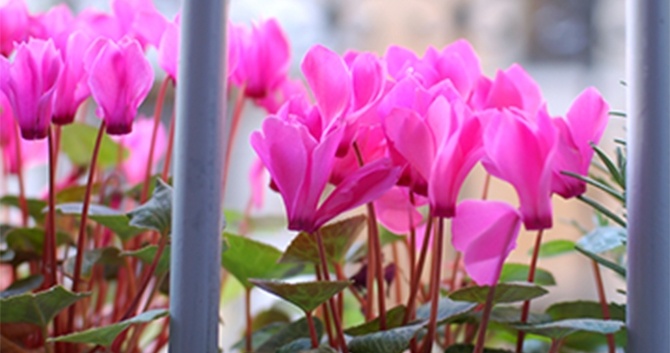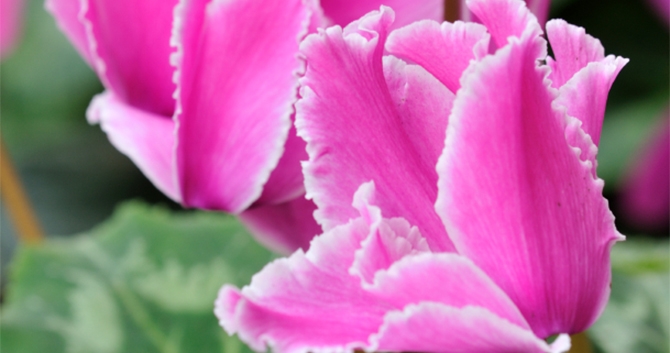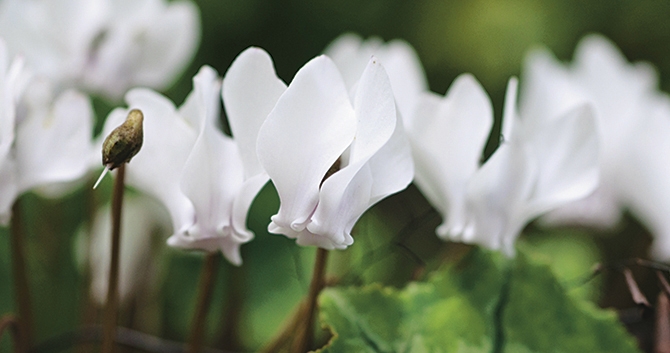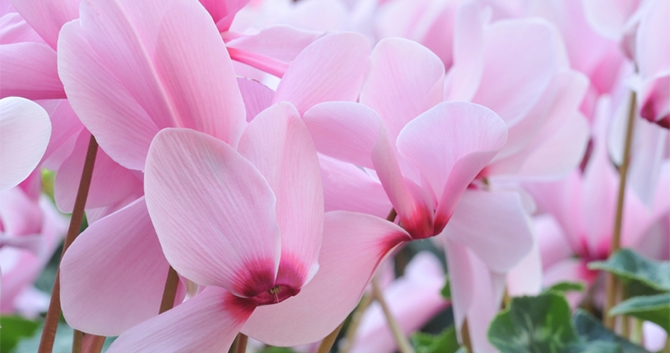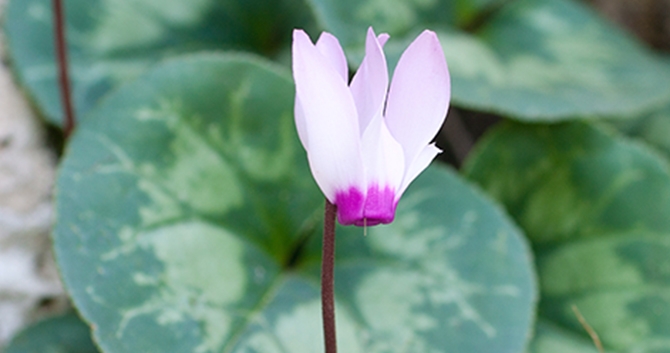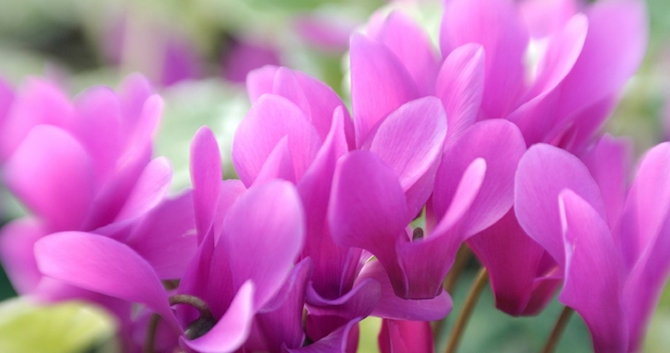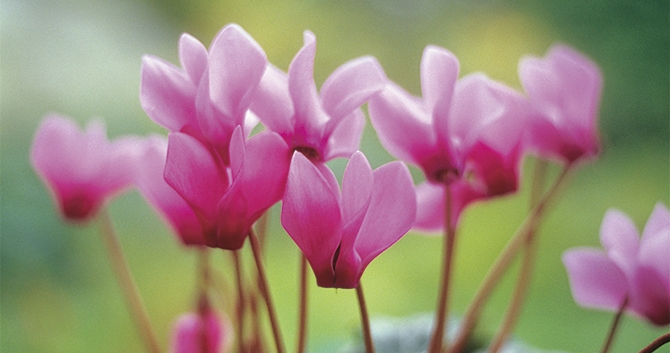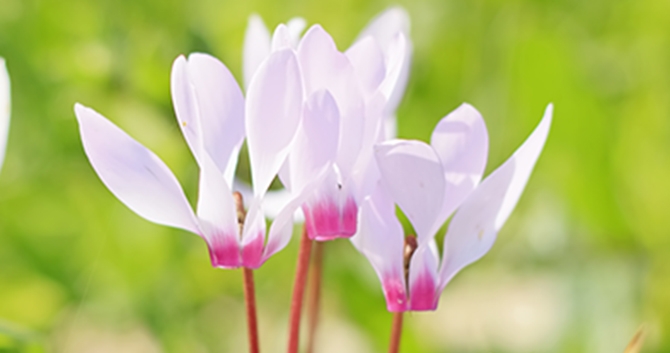Whether you’re looking for the perfect gift, or for a colorful indoor plant to brighten those long winter months, look no further!
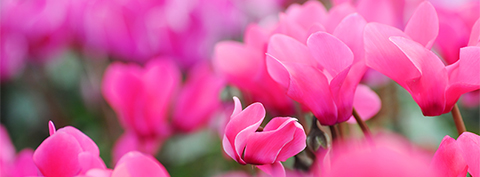 Cyclamen's graceful blooms resemble upswept ballet skirts
Cyclamen's graceful blooms resemble upswept ballet skirts
Cyclamen is poetry in motion, with beautiful green variegated foliage and graceful blooms like upswept ballet skirts in shades of white, pink, red, or purple. Its sweetly scented flowers add the subtle fragrance of heather, honey, lily-of-the-valley, cucumber, melon, fresh rhubarb, or fresh greenery to your home. The white, pink, and purple varieties are generally more fragrant, while the red varieties are bred more for their vibrant color.
Cyclamen is a genus of 20 species native to the Mediterranean, growing wild throughout Central and Southern Europe, Northern Africa, the Middle East and Iran. A member of the primrose family, cyclamen grows from tubers that flower in the winter months and then go dormant in the dry Mediterranean summers before re-emerging in the fall.
Cultivation of florist cyclamen began in the 1650’s when Victorian botanists in England and the Netherlands began cross-breeding hybrids of Persian cyclamen (cyclamen persicum) to transform the shy wild blooms into today’s larger showy flowers. The palette has expanded to include striking ruffled blooms, two-tone flower colors and a wide assortment of plant and bloom sizes.
Selecting Plants
When buying cyclamen, look for plants with only a few open flowers and lots of tight buds just beginning to open – this ensures you’ll enjoy its peak bloom time after you get home. Choose plants with beautiful foliage as well as pretty flowers.
Be sure stems are straight and leaves are green– drooping stems or yellow leaves can be a sign the plant is stressed. Gently inspect the base of the plant to ensure that it is healthy; the top of the tuber should be visible and firm to the touch.
Care Tips
Even the novice gardener can enjoy cyclamen’s beautiful winter blooms and sweet fragrance. It’s an easy plant to maintain, requiring minimal attention other than watering, periodic misting, occasional fertilizing, and frequent admiring looks.
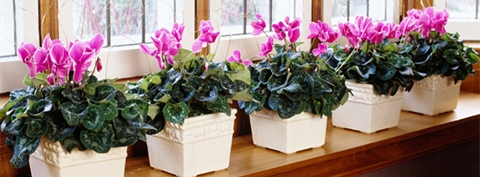 Place your cyclamen near a window where it will get indirect light
Place your cyclamen near a window where it will get indirect light
When you get your cyclamen home, place it in a cool room and follow these few simple tips to prolong blooms for several months.
Temperature: Cyclamen prefer temperatures between 55 and 68 degrees Fahrenheit. If that is too cool for your comfort, keep in mind that warmer temperatures shorten the bloom time but won’t otherwise harm the plant. You can compromise by placing plants in a cooler spot at night.
Light: Cyclamen prefer bright but indirect light. Find a spot up to four feet way from a north window, up to eight feet from a south window, or up to five feet from an east- or west-facing window. Keep your sheer curtains closed to filter and diffuse the light.
Water: Cyclamen like moist soil, but can’t tolerate standing water. Only water when the soil feels dry to the touch. Soak your plant from the bottom – tubers are susceptible to rot and should be kept dry. Before watering, remove the decorative pot cover. Soak your plant in the sink or in a shallow pan of water for about a half hour. Allow the plant to fully drain before replacing the pot cover and returning your cyclamen to its normal display location.
Misting: Cyclamen like high humidity and benefit from misting a few times a week. Alternatively, to raise the humidity around your plant, try placing your potted cyclamen in a pebble tray—a shallow saucer with small, uniformly-sized pebbles lining the bottom. Pour water into the saucer without completely covering the pebbles, so the plant is sitting above, not touching the water.
Fertilizer: When your cyclamen is blooming and growing new leaves, apply water-soluble fertilizer when you water. Choose a product recommended for flowering houseplants, following package instructions.
Encourage continuous flowering by removing any finished blooms. Simply twist the stalk and tug sharply to remove the spent flower. Also remove any yellow leaves to keep your plant looking its best.
After Flowering
Once your cyclamen has finished blooming, it may go dormant for a period of time, usually in the summer, although indoor conditions may confuse the timing. Leaves will begin to yellow and gradually die back before disappearing completely.
At this point, you may be debating whether to keep the plant, hoping it will revive in the fall or to discard it, replacing it with a new plant for the summer months. Although it might be tempting to get another season out of your cyclamen, it can be a challenge to get it to re-bloom.
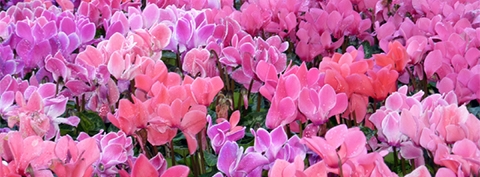 Cyclamen will bloom in shades of pink, red, and purple for months
Cyclamen will bloom in shades of pink, red, and purple for months
If you want to give it a try, stop watering the plant and make it comfortable during its dormancy period. Find a sheltered spot outside with morning sun and afternoon shade. Tip the pot on the side so it won’t get waterlogged, protect it from the rain, and keep the soil dry. You could also keep your plant indoors in a cool, dark location such as a basement until fall. Water it about once a month to keep the soil from going bone dry.
In early late August or early September, repot your cyclamen in fresh soil and a slightly larger container. Water sparingly until new growth begins and be patient - it may take a month. Once new growth starts to emerge, resume regular watering and fertilizing. You should get to enjoy your beautiful blooms again in a few short months.
Troubleshooting
Although cyclamen are low-maintenance plants, they will let you know when they’re not getting what they need. Here are solutions to some problems that may arise:
If leaves begin to wilt or the tuber becomes soft and mushy, you’re most likely over-watering! Too much water is the number one cause of houseplant problems – avoid the urge to saturate your cyclamen. Always check the soil to make sure it is dry before watering.
If your plant only flowers briefly, your room is either too hot or the air is too dry. Try moving your cyclamen to a cooler room and set up a pebble tray, or mist more frequently.
If the leaves are turning yellow, it may be too hot, too dry, or getting too much sun. Try moving it to a cooler spot with lower light and keep it evenly moist and misted.
If you begin to notice twisted, stunted leaves, you may have cyclamen mites. Smaller than the head of a pin, they live on the underside of the leaves. You can remedy mites by washing the leaves with tepid water, then spraying with an insecticidal soap.

